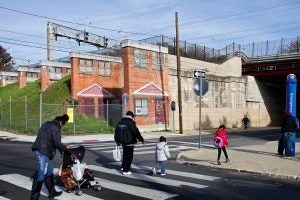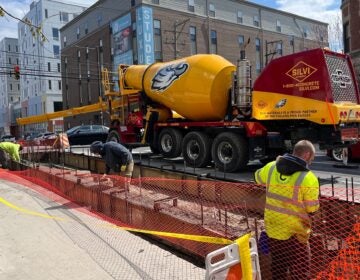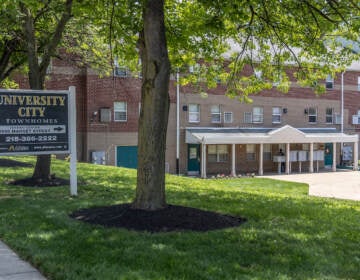As Drexel transforms University City, communities nearby prepare for gentrification
Listen 5:23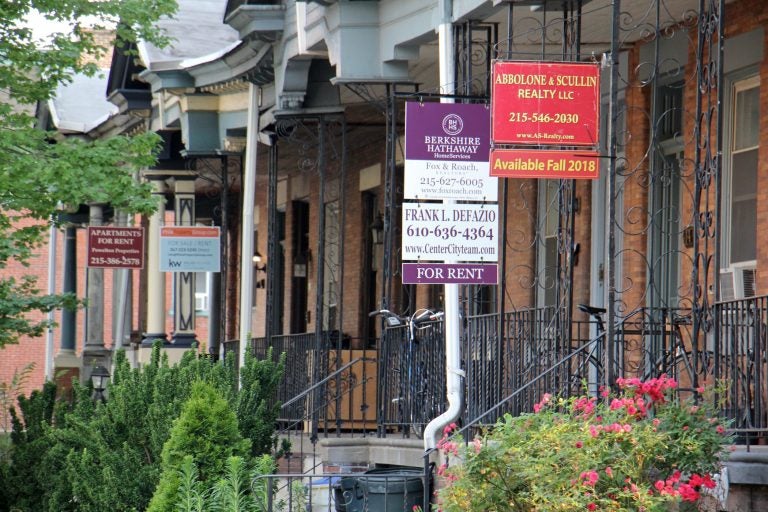
File photo: Rowhomes at 34th and Spring Garden streets for sale or rent. (Emma Lee/WHYY)
When Schuylkill Yards was first announced – Brandywine Realty Trust’s proposal to turn 14 acres of largely empty, Drexel University-owned land between the college and 30th Street Station into 7 million square feet of high-end office space, research labs, and retail – Drexel President John Fry made a pledge to the university’s neighbors: “This 20-year, $3.5 billion project will benefit thousands of low-income families without disrupting the fabric of their neighborhoods.”
It’s a bold pledge, and not one Fry was required to make. Many colleges adopt an attitude of benign indifference to the surrounding community; others engage in outright hostility. Both perspectives have their defenders, who will argue that a college’s obligation is to its students, alumni, and faculty — and no one else.
Nor was Fry making the promise naively. He knows exactly the kind of transformative impact a college can have, having overseen much of the University of Pennsylvania’s effort to improve the neighborhood surrounding it starting in the late 1990s and taking off in the early 2000s. Penn’s West Philadelphia Initiative to clean up and enliven the neighboring communities worked better than anyone ever imagined.
Penn didn’t plan for its runaway success and the accompanying troubles that it caused – the Ivy League school didn’t realize at the time how effective its policies would be. As Penn’s former president Judith Rodin wrote in “The University & Urban Renewal,” her book on the topic: “Analysis of other university-led efforts had demonstrated how the unintentional forces of upward mobility and the transmigration of populations from one neighborhood to another can destroy ethnically, racially and economically mixed communities. These efforts often wiped out the character of a community by failing to provide the mix of housing options that sustain a diverse neighborhood.”
Now at Drexel, Fry is instituting policies nearly identical to those first deployed at Penn 20 years ago, policies that produced some of the most acute gentrification Philadelphia has ever seen.

Same policies, different neighborhoods?
In 2014, Drexel opened the Dornsife Center for Neighborhood Partnerships in Mantua, creating a space for community meetings, social services, and adult education classes, including workforce-development classes through the University City District’s West Philadelphia Skills Initiative. Drexel changed its procurement rules to favor local vendors. Faculty and staff are encouraged to buy homes in the area, supported by generous forgivable loans and matching grants from Drexel, which also fixed street lights and extended its campus police patrols to deter crime. Once inward-facing, the campus turned to the streets, with bustling new restaurants and shops opening up on formerly barren blocks.
Drexel has partnered with another developer, Wexford Science & Technology, to redevelop the 14-acre former University City High School site just west of its campus. That proposal, uCity Square, calls for a smattering of new office buildings totaling 6.5 million square feet — roughly the equivalent of nine new Cira Centres.
Part of this site has been set aside for the construction of a building for Science Leadership Academy Middle School, which started in 2016 and now holds classes in the University City Science Center. The middle school is another Drexel partnership — and another callback to the University of Pennsylvania’s West Philadelphia Initiative. Penn donated land, teaching expertise, and $1,330 per student to help the School District of Philadelphia build the Sadie Alexander School in 2001. Almost immediately, property values started spiking in the top-notch neighborhood school’s catchment area.
Drexel is arguably doing more for Science Leadership Academy than Penn did for the Alexander School — it didn’t just donate the land, it bought it, and it will cover the cost of building the school. The university is now raising $40 million to start construction; so far, it’s gotten a little more than half from donors and is looking for grants and other capital sources.
“The emphasis on public safety, affordable housing, investments in public schools, creating opportunities for growth and development in the local economy by targeting our spend on construction and procurement of goods and services towards local, minority-owned, women-owned West Philadelphia businesses – a lot of that is absolutely the same, and that worked well at Penn, and I think we’ve been able to refine it and tailor it so that it works well at Drexel in a different set of neighborhoods,” Fry said in an interview.
In 1995, the average home in University City sold for $78,500. By 2003, homes there were going for $175,000. Today, the neighborhood just west of Penn’s campus is one of the city’s more desirable, and the average home value is nearly $500,000. Between 2001 and 2011, the neighborhood’s black population declined by more than half. Critics called it Penntrification.
“If you put money into a place, that money will be capitalized into land values and home prices,” explained Ken Steif, director of the Urban Spatial Analytics master’s degree program at the University of Pennsylvania. “When Penn did the many interventions that they did in West Philadelphia, it was specifically to change the neighborhood. And they succeeded.”
“I sincerely hope that it’s not the future of this neighborhood,” said Blaise Tobia, the outgoing president of the Powelton Village Civic Association.
According to Tobia, the development pressures haven’t been as bad in leafy, relatively well-off Powelton Village as in neighboring West Powelton and Mantua. “They have had a rash of demolitions, building of cheap, four-story student housing with no regard to detail, no regard to architectural similarity to adjoining neighborhoods.”
Now, two years after Drexel and Brandywine Realty Trust first announced their sweeping real estate project, construction crews are busy turning an old, drab plaza into the lush Drexel Square, a 1.3-acre park and the first phase of the Schuylkill Yards development plan.
Fry is quick to point out that this will be a public commodity – a gift to the city, really. But it’s also a key first step in attracting would-be tenants to the skyscrapers Brandywine wants to build around it. As the company’s CEO, Jerry Sweeney, put it, “Drexel Square, that’s the postcard on what will capture people’s imagination about what that space can be, as opposed to just gray parking lots.”
If all goes according to Brandywine and Drexel’s plans, the skyscrapers will hold at least 40,000 high-paying jobs – 50,000 if Amazon picks Schuylkill Yards for its second headquarters. Along with Wexford’s uCity Square and other developments in the area, the number of jobs in University City could more than double over the next two decades, becoming a hub for innovative, and high-paying, biomedical and tech firms.
Many of the white-collar newcomers filling those jobs will spill out into the surrounding neighborhoods to find homes. “Neighborhoods like Mantua, they’re like blank canvases to developers,” said James Wright, director of community, economic and real estate development at the People’s Emergency Center (PEC), which builds affordable housing in the area.
Real estate pressures from Schuylkill Yards and uCity Square will compound the already sizable property-value appreciation underway in the communities just north of Drexel’s campus. University City has been growing as an employment hub for years now, and the gentrification of Spruce Hill just west of Penn’s campus nearly twenty years ago has spread to neighboring Walnut Hill and Cedar Park.
Fry insists that Drexel’s implementation of policies nearly identical to the ones Penn deployed west of its campus won’t result in the same intense gentrification in Mantua and Powelton. “I think these are very different neighborhoods,” he said. “I think if you look at the Spruce Hill neighborhood, which is immediately west of Penn, I think its sort of configuration — both physically and in terms of its population — is very different from neighborhoods we’re dealing with.”
He points to the existence of strong, established community-development corporations like PEC and Mount Vernon Manor — which also focuses on providing and maintaining affordable housing in the area — as another reason why Drexel’s master plans won’t have the same impact on adjacent communities as Penn’s did with its neighbors. Back then, there were no groups in Spruce Hill or Walnut Hill focused on affordability.
Drexel’s faculty has also been more engaged in working with the community, Fry added, noting how law professors oversee legal clinics to help Mantua residents with issues such as tangled titles. “What’s very different — and, to me, much more profound — is the level of engagement of our faculty,“ he said.
“So, I think these are two completely different neighborhoods with two completely different sets of issues,” Fry continued. “A lot of [Drexel’s investments in the area] is just providing basic supports and services and training and education for people, and there is no sort of real estate investments we are making.”
Wright doesn’t necessarily disagree. “I think Mantua, Belmont and some other neighborhoods have a lot more challenges, so the starting points are different,” he said.
But while the starting points may differ, Wright expects the results will largely be the same. “There was a lot more brick in the way in Spruce Hill, less brick in Mantua,” he said, referring to Mantua’s greater number of vacant lots and abandoned homes, “which means the turnover could happen really quickly.”
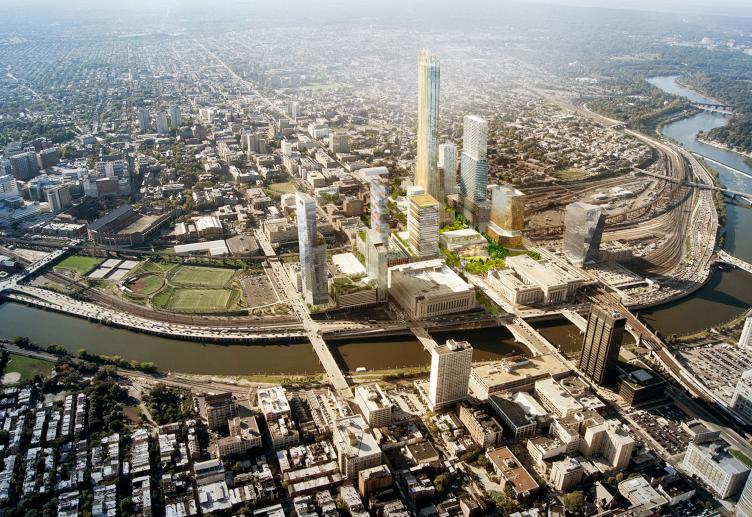
Fry also points to the existence of PEC and other community groups as a reason why Mantua and Powelton Village won’t end up like Spruce Hill. But civic leaders in those neighborhoods aren’t so sure.
“My grandfather always used to say, ‘They’re coming,’ ” said De’Wayne Drummond, president of the Mantua Civic Association. “Now, I know what he meant.” Drummond’s grandfather saw firsthand what happened to the “Black Bottom” in the 1960s, when a vibrant African-American neighborhood along Market Street was cleared to make way for the University City Science Center. To many in Powelton and Mantua, it was only a matter of time before the universities extended their ascendancy into the neighborhoods.
Wright agrees that the existence of longstanding groups like PEC, Powelton Village Civic Association, Mantua Civic Association, and Mount Vernon Manor CDC — which collectively form the Mantua-Powelton Alliance, an umbrella group formed in response to the real estate pressures from Drexel’s development plans — means the community sees the gentrification coming down the pike and can ready itself for it.
But, he noted, “Even though they are more prepared mentally, and understand what’s happening, they don’t necessarily have the resources to do something about it.”
“The truth is, Drexel is a business, you know? And they have a bottom line that is different from the community,” said Wright. “And their bottom line is great, because it’s a great product, it’s a great university, they’re trying to do wonderful things for their constituents – for their students primarily.”
Fry bristles at the idea that there is anything but altruistic motives behind Drexel’s efforts to improve the area surrounding it.
“If you take a look at the investments, the hard capital we put into West Philadelphia, most of it has been not for the benefit of our university, but for the benefit of those neighborhoods.” Fry said. “The fact is, I think we feel like a kind of important sense of responsibility to the neighborhoods that surround our university because a great institution not only cares about itself, but it cares about others.”
Though the community investments may not provide direct, immediate benefits to Drexel, it’s difficult to argue that this isn’t, at the very least, enlightened self-interest. Fry has, after all, called on Drexel to become “the nation’s most civically engaged university,” as a way of distinguishing itself from its academic competitors.
Drexel’s strategic plan, entitled “Transforming the Modern Urban University,” lists the creation of a “dynamic transportation hub-based university district,” alongside other initiatives like “invest in academic excellence,” and “enhance Drexel’s global impact.” Drexel’s Master Plan is as much about the area surrounding the school as it is about the campus itself, describing the university as “an institution that anchors an urban district.”
For a vision that purposefully blurs the lines between campus and community to succeed in the eyes of students, faculty and trustees, that community cannot be one mired in poverty. The goal of Fry’s protracted place-making experiment is a space of academic and economic cross-pollination to rival Cambridge, Mass., and Silicon Valley. And, like those places, the success of Drexel, Schuylkill Yards, and uCity Square may anchor the city’s economic growth and prosperity for decades.
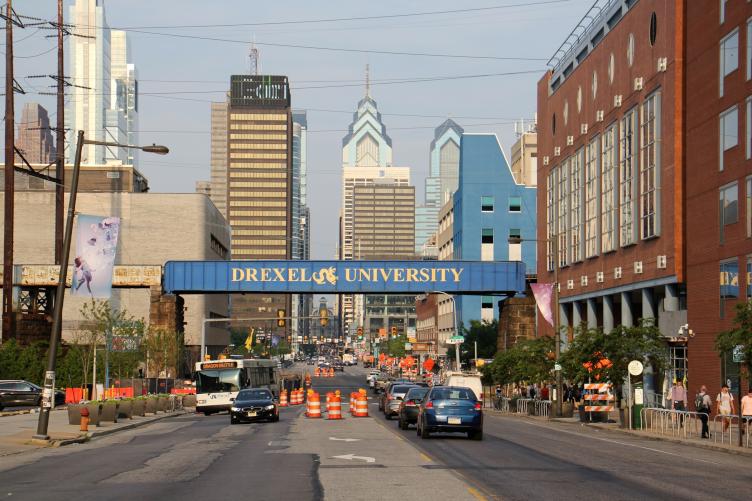
Negotiating change
The Mantua-Powelton Alliance signed a community benefits agreement with Brandywine Realty that gives it $3.1 million over five years to use for affordable housing and workforce-development grants. Brandywine has also pledged to encourage its tenants to hire local businesses as vendors, promising to cover 10 percent of the cost of a contract with one for the first year and to provide $500,000 in seed capital for a low-interest loan program for local minority-owned businesses to be run by the Enterprise Center.
Will that be enough to prevent displacement? “Absolutely not,” said Wright. “But the goal, or the hope, is that the Brandywine resources will serve as a catalyst that can attract other resources to help improve, or work toward mitigating, slowing, or easing the pressures of gentrification.”
“However, and this is true, the developer — Jerry Sweeney and Brandywine — they say, ‘Well, we shouldn’t be the ones that bear the whole burden for preserving this community,’ because they’re not the only developer in this space,” added Wright. “And that’s very true.”
Smaller developers — like those who have drawn the neighborhood’s ire by tearing down and replacing old Victorian rowhouses with boxy student apartments — largely skirt the radar. Most build by-right, meaning they don’t need to seek any additional zoning approvals to begin construction, eviscerating any leverage the community groups might have against them.
“You can’t expect Brandywine to shoulder the whole burden of making an equitable community,” Wright said. “I don’t really think [the community benefits agreement] is as fair as it could be. But it’s a lot more fair than anything that has ever happened in Philly.”
Sweeney is quick to point out that the $3.1 million CBA is just for Schuylkill Yards’ first phase. “Both the community groups and Brandywine expect that, as we move through the overall implementation of our plan for Schuylkill Yards, that we’ll engage with them on CBAs for the future phases. So we’re very cognizant of the impact, both very positive and potentially negative, that Schuylkill Yards can have on the adjoining neighborhoods.”
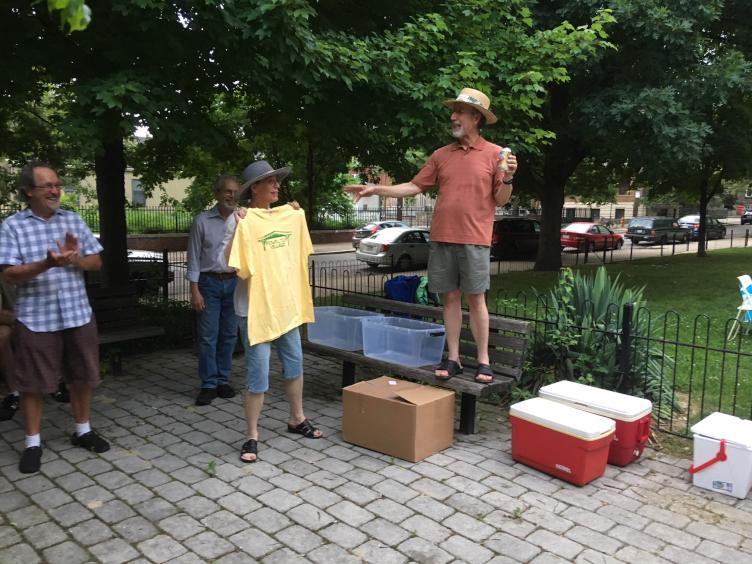
Development Schizophrenia
Like most cities in Pennsylvania, Philadelphia doesn’t really have a coherent economic-development strategy. Or, as Sweeney put it, “Philadelphia is a lot less linear [than other cities] in how the process works.”
“There are some processes that developers have to go through in Philadelphia, and I’m sure you can talk to a lot of our fellow developers, where the process can be somewhat unfair, can be arbitrary, can be unpredictable, and that’s where I think it raises the frustration levels with people,” said Sweeney.
“Sometimes, when the process becomes a bit unpredictable and non-linear is where it adds time and money,” he added. “Or, when you don’t have the regulatory agencies that work well together or seamlessly create a predictable approval process [that also costs time and money].”
Critics say that Philadelphia’s convoluted construction-approval process, and the amount of power it gives to registered community organizations to block or delay projects, contributes to the city’s relatively high costs of construction, which makes building affordable housing that much more difficult financially. Most new construction in the city is marketed toward wealthier buyers.
Sweeney says he’s fine with the amount of outreach required to build in the city. “When you create new spaces, it does have an impact. I happen to believe it’s usually positive, but not everybody shares that perspective,” he said. “So, I think from a philosophical standpoint, we’ve always welcomed engagement, knowing full well that that engagement costs us money, but we view that as part of the process of creating something of value.”
In fact, Sweeney argues that Philadelphia’s difficult building regime even makes Brandywine money, because it’s both an investor and a developer, and the city’s idiosyncrasies keep competitors away.
“So, while you might be frustrated as a developer, as an investor, you look for markets where it’s harder to build.”
On one hand, all across the state there are hundreds of Keystone Opportunity Zones, areas where companies and builders that locate jobs can avoid paying most local and state taxes for a few years. As of 2014, a total of 46,000 acres — or about the combined size of Pittsburgh and Harrisburg — were basically tax-free zones. Schuylkill Yards lies in a KOZ.
On the other hand, however, Brandywine was basically forced to fork over a few million dollars in the community benefits agreement, plus make the other promises, before City Council would authorize the upzoning needed for Schuylkill Yards’ cloud-tickling skyscrapers.
Like a lot of cities across the United States, Philadelphia has been growing the last dozen years or so, after decades of decline. And like most cities, Philadelphia doesn’t have a strategic plan for managing that growth.
So, instead, it falls to an ad-hoc group of civic associations and politicians to negotiate concessions from developers like Brandywine and institutions like Drexel to blunt the disruptive side effects of new developments.
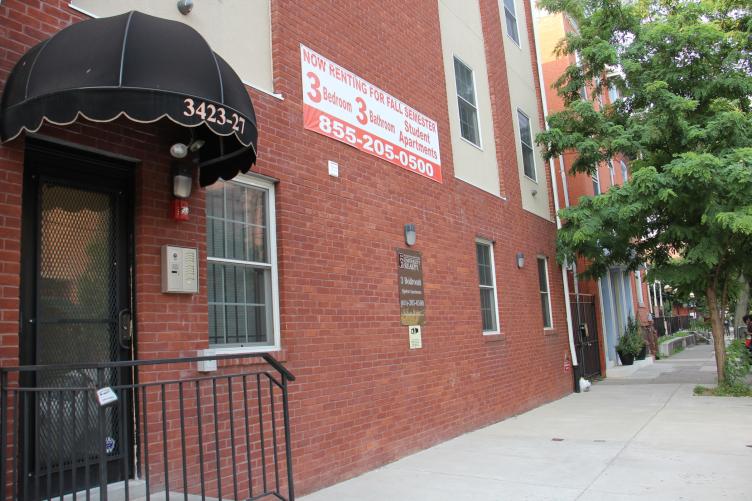
It’s true that, as Fry noted, Drexel has not made the same direct real estate investments in Mantua as Penn did in Spruce Hill. Penn invested along the edge of its campus, most notably rejuvenating the retail spaces along 40th Street. Penn also created a Neighborhood Housing and Development Fund that financed the rehabilitation of more than 200 rental units between 40th and 49th streets. For the most part, Drexel’s recent, direct real estate developments have clustered along Market and Chestnut streets, towards the southern edge of campus that abuts Penn.
But in Schuylkill Yards and uCity Square, Drexel is proposing developments that are orders of magnitude greater than anything Penn ever envisioned.
(The expansion of Penn’s hospital complex occurred at the southeastern edge of campus, placing more development pressure on the Graduate Hospital neighborhood than on the west end of campus a mile away. During this period, Grad Hospital gentrified rapidly. While neighborhoods with predominantly African-American populations are generally less likely to see gentrification compared to predominantly white or Latino areas, a 2016 Pew report found that Graduate Hospital was one of the few gentrifying neighborhoods in Philadelphia that was predominantly African-American; the others included Spruce Hill, Walnut Hill, and Cedar Park next to Penn and West Powelton next to Drexel.)
Still, Fry doesn’t think the multibillion-dollar investments in office and retail complexes will significantly affect Mantua, Powelton or Belmont. “With the mass-transportation access that we have there, I don’t think that means an immediate sort of spillover into the neighborhoods,” he said. “Some may choose to live in West Philadelphia. But as many, if not more, will choose to commute to other parts of the Philadelphia region.”
Others disagree.
“If 40,000 people move to Schuylkill Yards… some amount are going to want to live in a neighborhood,” said Steif, the Penn urban-studies professor, whose research has used analytics to predict gentrification. “They are going to move to Mantua and the land values are going to skyrocket, and that will have very negative effects on the level of affordability.”
“The neighborhood is going to change,” Wright said. “I mean, $3.5 billion in any focused area is going to just make all kinds of ripples.”
“We know both the Schuylkill Yards development and the uCity Square development on the former University City High School site are going to bring additional development pressure, price-increase pressure, to Powelton Village, and to Mantua, and to West Powelton,” said Tobia. “There’s no way that they’re not going to do that.“
While Drexel maintains that history will not repeat itself and that its community interventions are being made with the best interests of the current residents in mind, officials admit that Philadelphia’s lack of gentrification management can be frustrating as they catch flak for improving the area’s safety and upgrading its public spaces.
“There are some policy questions, about what responsibility does a city have to manage real estate growth and, by the way, whose responsibility is it — is it the private sector or the public sector?” said Lucy Kerman, senior vice provost for university and community partnerships at Drexel.
Kerman, who also worked with Fry at Penn, has led Drexel’s outreach effort in the communities abutting the campus, an effort that’s largely applauded.
“It seems they have tried to be very intentional about that,” said Wright. “Prior to John Fry happening, coming to Drexel, it wasn’t as much. We were definitely in conversation, but we weren’t as intentional about working together as we are now.”
Tobia, who spent 25 years teaching art history at Drexel, echoed Wright. “With the arrival of John Fry, Drexel has spoken a very good line about wanting Powelton to be a healthy, vibrant neighborhood next to the Drexel campus and has, in fact, done some very important things,” he said. “At the same time, there’s just inherent differences in points of view in what is necessary between Drexel and Powelton.”
Kerman gets why, despite all the outreach and positive relationships forged, there still isn’t much trust. After all, town-gown relations are often fraught in the best of situations, and longtime residents here still carry the psychological scars of what happened to the Black Bottom.
“It’s totally understandable that there will always be a concern about big institutions next to neighborhoods,” she said.
“I think it’s also realistic to say that there’s change coming, and it’s extremely hard for communities throughout Philadelphia to deal with change, and know how to own the change,” Kerman added. “The question for Philadelphia is: Are there structures that can exist that can manage real estate growth?”
It’s a question Steif also asks himself. “Do we have the planning apparatus in place to absorb that kind of demand for housing without putting displacement pressure on our peripheral neighborhoods?” he asked, referring to Schuylkill Yards. “At this point, I don’t think we do. I think we’re moving in the right direction, but I don’t think we’re there yet.”
Kerman thinks city government could be more strategic in overseeing growth while maintaining relatively affordable housing, especially in how it handles city-owned property.
“[The strategy] lies in a citywide analysis of expiring tax credits, it lies in a citywide analysis of publicly owned land that could be transferred to private ownership, and what would we like to see and what the best thing is for neighborhoods — they probably shouldn’t all be built up, they probably should have parks, they should have mixed income — and there’s a certain amount of control that city has in the disposition of city property that supports that,” said Kerman.
Though the community groups focus a lot on affordable housing, meaning homes and apartments priced at below-market rates, they have also taken steps that Steif says will ultimately decrease the amount of housing that’s affordable in the area.
Last year, the Mantua and Powelton civic associations finally convinced City Councilwoman Jannie Blackwell to downzone most of their neighborhoods, decreasing the number of units developers can build by-right. The civic groups had advocated for this change for years to curb the increase in student-centric apartment complexes driven by Drexel’s large growth.
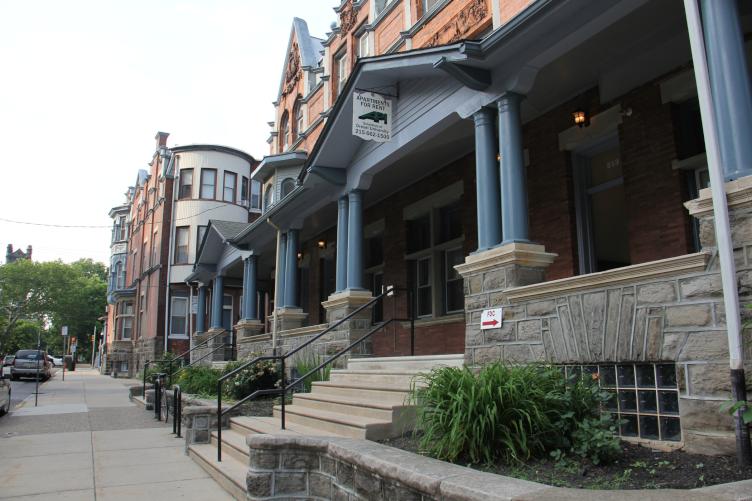
A rash of student apartments
Drexel’s enrollment more than doubled under Fry’s predecessor, Constantine Papadakis, from about 9,000 students to 21,000, including 11,000 undergraduates. Today, total enrollment is 24,300 and rising – freshman enrollment in 2017 was 3,100, well above the 2,400 of the year prior. The university’s master plan calls for even more growth – 34,000 students by 2021. Under Fry, Drexel has built two new on-campus apartment buildings and added 3,000 beds in recent years, but it still provides on-campus housing for only 6,680 students.
That’s enough to require freshmen and sophomores to live on campus, but most of the upperclassmen must turn to the surrounding neighborhoods for accommodations. The doubling of the student population led developers to turn to Mantua’s vacant lots to supply Drexel’s growing demand for student housing, knocking down old homes to make way for new apartments – mid-rise buildings filled with two- to four-bedroom units with little living space. In other words, the kind of living arrangement that works for students or recent graduates, but not families. And the price – about $1,000 per month per bedroom – is aimed at the price-insensitive college kid whose rent comes from parents or student loans. (What’s an extra few grand a year in housing costs when you’re paying $52,000 a year in tuition?)
Fry admits the school’s inability to keep up with student housing has hurt town-gown relations. “It’s distressing because, almost more than any gentrification we would see, I think we’re seeing a sort of studentification.”
“But we can’t control the market,” Fry added. Drexel can – and does – participate in it, though. Drexel has partnered with Texas-based American Campus Communities to offer university-affiliated housing options, offering two- to four-bedroom student apartments at prices of $800 per month per room, but rent can go much higher.
“I was paying over $1,000 a month,” said Amy Gottsegen, a fourth-year computer science major at Drexel. “A lot of people just can’t afford that, so they have to move off-campus and that ends up displacing people.”
Gottsegen said Drexel started pressuring her on the need to secure an on-campus apartment just weeks after she arrived. “When I was a freshman, by October [or] November, I was getting this deluge of emails and fliers about how I had to sign up for sophomore housing,” she said. “I had just gotten to college and didn’t know anyone, so not only was it very stressful, but I ended up renting this unit that was way out of my price range because it seemed like what I had to do.”
She soon moved off campus, to an apartment in West Powelton, and saw her rent drop in half. Many of her classmates make similar moves.
“There is an inherent difference between Drexel and Powelton Village,” said Tobia. “That is: Lots of students are good for Drexel. Lots of students are not very good for Powelton.”
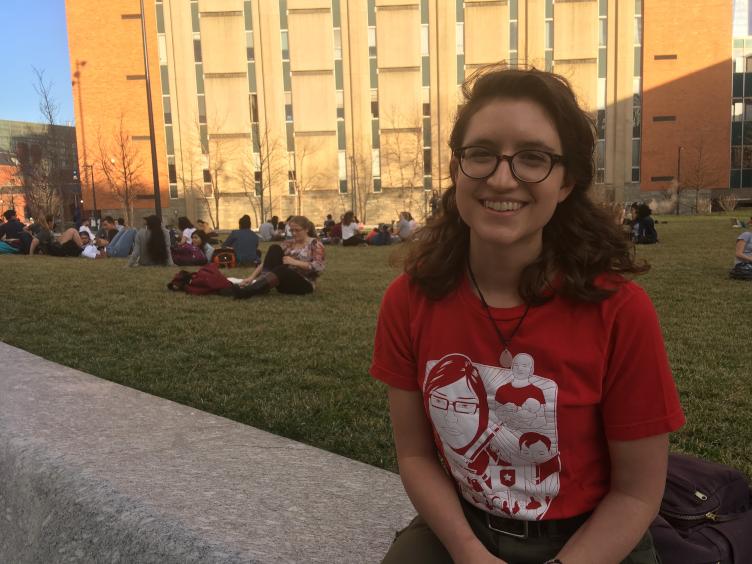
Former Penn president Rodin touched on how colleges can influence the housing decisions of students like Gottsegen in “The University & Urban Renewal.“
“It is important to note that a university can affect the neighborhood housing market dramatically simply by changing its own on-campus housing policies and practices, such as the number of available on-campus beds for undergraduates, the quality of the on-campus residential experience, and whether or not students are required to live in campus housing if it is available,” Rodin wrote.
Drexel has supported Mantua and Powelton’s efforts to downzone their neighborhoods, giving the registered community organizations there more power to block student-housing projects.
Zoning most of the area for single-family housing has given the civic associations more power over what is built in the area. Developers who want to build something denser will need to seek a variance or special-use exemption, which means they’ll need to at least ask the local registered community organizations for support before going before the Zoning Board of Adjustment or begging City Council to rezone a specific parcel.
That means many developers won’t even try to build larger projects there, limiting the supply of new residential units just as demand to live in the neighborhoods begins to spike.
So, the local registered community organizations have fought and continue to fight for more money for affordable housing. But, at the same time, they’ve added barriers limiting the amount of new units that can be built, which will increase property values.
It’s a seemingly schizophrenic approach that can be explained, in part, by their differing interests: The People’s Emergency Center and Mount Vernon Manor CDC try to create and sustain affordable housing; the civic associations mostly represent homeowners. For them, the aim is to ride out gentrification, watching their property values rise as the neighborhood improves.
“Our neighbors — my neighbors — would like this neighborhood to stay the way it is as much as possible,” said Tobia, of the Powelton Village Civic Association. To him, that means keeping Powelton Village a relatively affordable neighborhood full of stately Victorian twins that families with children call home.*
Programs like the Healthy Rowhome Project, which repairs dilapidated owner-occupied homes, help these residents capture some of the economic gains gentrification can bring. That’s one of the tactics the Mantua-Powelton Alliance is considering supporting with the CBA funds.
Most recent academic studies on gentrification suggest that the most derided aspect of it — displacement — is relatively rare. According to a recent study by the Federal Reserve Bank of Philadelphia, homeowners in gentrifying neighborhoods are no more likely to leave than owners in non-gentrifying areas, despite increases in property taxes. The implication was that these homeowners could weather the increases, often helped by policies like the Longterm Owner Occupants Program.
An earlier study suggested that renters — who can face much more sudden and dramatic increases in their rent when real estate prices rise — are also not significantly more likely to leave a gentrifying neighborhood. According to a 2016 study, rental households in gentrifying areas were about 2.6 percentage points more likely to report an “involuntary move” in the past two years than those in non-gentrifying areas. As it is, renters tend to move frequently no matter what — they average a move every 1.7 years. So being in a gentrifying neighborhood raised the likelihood of a renter feeling forced to move from 13 percent to 15.6 percent.
Rising property values can be a good thing for homeowners who can afford higher real estate taxes. But fewer than one in four Mantua and Powelton residents own their own homes. While renters have come and gone from the neighborhood for decades, increasingly the renters who leave will be replaced by wealthier residents.
Local community groups tend to be dominated by homeowners. For them, gentrification can be a massive economic boon.
“If somebody buys a house for $20,000 and sells that house for $200,000 ten years later, that is an economic win for that person,” said Steif. “But when someone is forced to leave that neighborhood from housing-cost pressure and they are displaced to a lesser neighborhood, that’s problematic, that would lead to a loss socially and economically.”
A Philadelphia Fed study in 2016 found “that vulnerable residents, those with low credit scores and without mortgages, are generally no more likely to move from gentrifying neighborhoods compared with their counterparts in non-gentrifying neighborhoods.”
That same study also found, however, that the worse-off residents that did move usually moved to lower-income neighborhoods, while better-off residents who left a gentrifying neighborhood usually upgraded to a nicer part of town.
Another Fed study in 2016 found that credit scores rose for residents in gentrifying neighborhoods — suggesting that gentrification helped, not hurt, their pocketbooks. That said, the positive impacts were smaller for the less-advantaged residents who stayed, and those who did move saw their credit scores drop.
Despite the growing mountain of quantitative data suggesting otherwise, the prevailing narrative around gentrification focuses on displacement, stoking fears that longtime residents will be forced to leave. But that’s not the sole concern as the neighborhoods around Drexel start to change.
“The idea isn’t to just keep it what it is, but the idea is, as things increase, that the people that are here now will not feel a sense of displacement socially and physically,” said Wright.

Who is gentrification for?
According to Wright, the Mantua-Powelton Alliance wants to leverage Brandywine Realty’s $3.1 million to seek additional grants and loans “for the preservation of affordable housing.”
But maintaining a healthy stock of reasonably priced homes isn’t the collective’s only goal. The groups also want “the preservation of the neighborhood identity that’s there, and the preservation of the diversity of resources and amenities that are in the neighborhood now,” said Wright.
“As things improve, we want people that are here now, the people that will come, to feel comfortable in that space.”
Though so much ink is spilled over the notion of economic displacement from gentrification, it’s this sense of sociological displacement that seems to really drive residents’ fears — that their neighborhoods will change so much, they won’t feel welcome there any more.
Here, race plays a major role. The stereotypical signs of gentrification — upscale coffee shops, gastropubs, dog-grooming shops, and the like — can send subtle, usually unintentional, signals that they don’t want business from the longtime residents, said Wright.
“The reality is, a lot of times the new businesses that are created are for them not me,” he said. “When I say ‘me,’ I mean the residents that are already there… how do you shape this for the existing residents?”
Wright thinks groups like his can help bridge the divide, offering advice to those entrepreneurs that move into Mantua or West Powelton how they can create inclusive, welcoming businesses for new and old residents alike. As the area’s transformation accelerates, it’s his goal to help ensure that the community feels as if it is actively participating in the changes, rather than passively having changes inflicted upon it.
“I want people to have a sense of being a creator of their own destiny, of having power in the situation that’s happening,” said Wright.
Drexel, for its part, says it wants the same.
“The challenge is how the neighborhood is able to own the change and participate in the change,” said Kerman. “My sense from the CBA, and the Mantua-Powelton Alliance that has been created as a result of it, is that body will take a very thoughtful approach to what it believes needs to be done to ensure continuing affordability in a mixed-income neighborhood.”
Drexel’s neighbors don’t really want to block the university’s growth or the nearby developments. Most talk excitedly about the economic opportunities nearby, the new park, and the preservation and renovation of the old Philadelphia Bulletin building at 30th and Market streets.
What they fear most is too much change, and that everything being built in and around their communities is being built for someone else, somebody new.
In other words, Drexel’s neighbors worry that, at a certain point, their neighborhoods will stop being their neighborhoods.
And so, as they watch gleaming new towers rise a few blocks away, these nervous neighbors find themselves wondering whether, 10 years from now, their houses will still feel like home.
This story is part of an occasional Keystone Crossroads’ series examining the impact of colleges and universities on communities in Pennsylvania. The series was made possible with support from the Knight Foundation.
*Editor’s note: This line originally had West Powelton, instead of Powelton Village.
WHYY is your source for fact-based, in-depth journalism and information. As a nonprofit organization, we rely on financial support from readers like you. Please give today.




